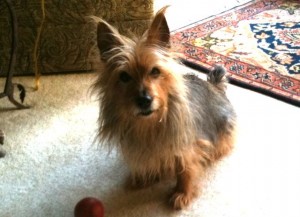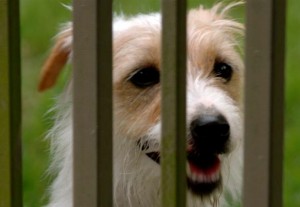 Please read Start Here AA-1 through AA-5 before you teach your dog to target.
Please read Start Here AA-1 through AA-5 before you teach your dog to target.
Crisco, the turbo Jack Russell Terrier in the picture, will almost always come when called. Crisco has been very well trained by her owner via the use of targets!
Here are some thoughts about targets introduced to me by Kayce Cover, B.S., M.A.
Targets give the dog critical information about where success will take place. Examples of targets are a simple wooden dowel with a piece of tape on one end for contrast, your hand, extended fingers, or other items such as a business card, ink pen, plastic lid from small food container, piece of tape on the wall, dot of light from a laser pointer, etc.. You can purchase a target stick from pet supply stores.
Many trainers use targets to teach service dogs how to operate light switches, press doorbells, open doors, pick up items, et cetera. The dog is taught to go to the target, bump the target with his nose (or any other body part) maintain contact with the target, sit / lay on the target, pick up the item touching the target, or any number of behaviors, depending on the type of target and the application.
The use of target(s) is an excellent method to teach motion behaviors or to teach the dog where a behavior should occur.
Simple applications for target sticks are teaching a dog to spin and to heel.
Target Touch
Here’s how to teach your dog to bump a two finger target. To form a two-finger target, extend your index and middle fingers and tuck your ring finger and little finger into your palm with your thumb.
You will present the two-finger target on a plane, horizontal to the floor, as if you are pointing to someone next to you. The dog will touch the outside or knuckle side of the target.
Say “Touch” and immediately position the end of the target one inch from your dog’s nose. He will sniff it. Do not move your target to touch his nose. He should come to you!
Mark the instant (with your conditioned marker) he touches your two finger target with his nose and immediately withdraw your target. Deliver a reward. Repeat three times, but place the target a bit farther away and to the left or right of your dog’s nose on trials 2 and 3. Now you can use the two-finger, nose target, to guide your dog into position.
Target Here – Foster a Partnership
The “touch” exercise is much more than a simple command. It is a very clear method to tell your dog what you’d like him to do and exactly where success will take place. It is a powerful tool for building an attitude of cooperation, a partnership.
The target provides a visual focal point, a precise point in space, where a behavior is to take place.
Using a target is one method to recall your dog. To use it for a come command, do this. Instead of saying “touch”, say “here” and then present your two finger target a few inches from your dog’s nose. Practice “here” at various distances in very short sessions. I usually practice this command 3-5 times during a short practice session.
I view “here” as a tool for nurturing a senior – junior partnership with Bentley. When I ask him to target, I’m really holding a two way conversation about cooperation.
I’m asking Bentley – “Hey Bent, I’d like you to come over here and bump my target with your nose. Do you understand what I want you to do? Do you understand where success will take place? Do you understand that I will pay you for your cooperation? Are you willing to cooperate? “
Bentley races over to bump my target. He’s replying, “Hey Alan, I know what you want me to do. I know where success will take place. I know you’re going to pay me. I’m willing to cooperate.”
Troubleshooting Target Here
Teaching your dog to touch your two finger target can be frustrating! Sometimes the dog will bite your fingers, or just quit targeting altogether.
If your dog is biting your target, check for these common errors. Review your timing and target placement. You should mark the instant he touches the target, not one second afterwards. Are you withdrawing your target immediately after you mark the instant he touches it? If you leave your target in place after the marker, your dog may mouth or bite the target. It’s best to remove your target immediately after you mark the touch.
If your dog sometimes ignores the target, review the placement of the target. Position the target nose height or lower. The target should be horizontal to the floor (as if you are pointing to something next to you).
What are your actions after he bumps the target? Are you moving the target towards the dog (thus bumping him right before he reaches the target)? Do you end his fun or mark the instant and give a reward?
Some dogs lose interest if you repeat the exercise more than 2-3 times during a short session.
 Print This Post
Print This Post
Happy Training!

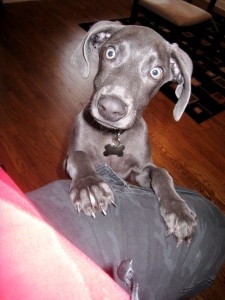 On April 17, 2009, the
On April 17, 2009, the 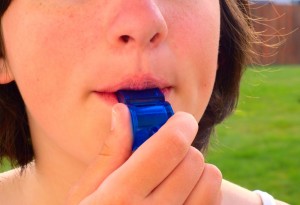 Whistle Come
Whistle Come Ear infections are common, especially in dogs with floppy ears. If your puppy or dog is constantly shaking his or her head or scratching his or her ears, there’s likely to be an infection.
Ear infections are common, especially in dogs with floppy ears. If your puppy or dog is constantly shaking his or her head or scratching his or her ears, there’s likely to be an infection. 
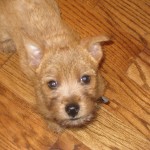 Click the You Tube link below this text to see Harry, the
Click the You Tube link below this text to see Harry, the 